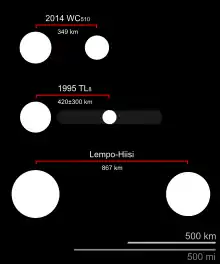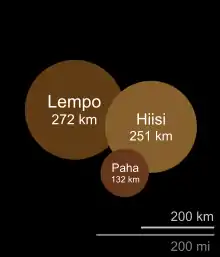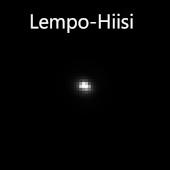47171 Lempo
47171 Lempo, or as a binary (47171) Lempo–Hiisi (also known as 1999 TC36), is a trans-Neptunian object and trinary system from the Kuiper belt, located in the outermost regions of the Solar System. It was discovered on 1 October 1999, by American astronomers Eric Rubenstein and Louis-Gregory Strolger during an observing run at Kitt Peak National Observatory in Arizona, United States.[2][10] Rubenstein was searching images taken by Strolger as part of their Nearby Galaxies Supernova Search project. It is classified as a plutino with a 2:3 mean-motion resonance with Neptune and is among the brighter TNOs. It reached perihelion in July 2015. This minor planet was named after Lempo from Finnish mythology.[2]
 Lempo-Hiisi and their outer companion Paha, imaged with the Hubble Space Telescope in 2001. Lempo and Hiisi are unresolved. | |
| Discovery[1] | |
|---|---|
| Discovered by | Eric P. Rubenstein Louis-Gregory Strolger |
| Discovery site | Kitt Peak National Obs. |
| Discovery date | 1 October 1999 |
| Designations | |
| (47171) Lempo | |
| Pronunciation | /ˈlɛmpoʊ/ |
Named after | Lempo (Finnish mythology) [2] |
| 1999 TC36 | |
| TNO · plutino[3] · distant[2] · trinary[4] | |
| Orbital characteristics[1] | |
| Epoch 31 May 2020 (JD 2459000.5) | |
| Uncertainty parameter 2 | |
| Observation arc | 45.46 yr (16,606 days) |
| Earliest precovery date | 18 June 1974 |
| Aphelion | 48.232 AU |
| Perihelion | 30.543 AU |
| 39.387 AU | |
| Eccentricity | 0.22456 |
| 247.20 yr (90,289 days) | |
| 7.8069° | |
| 0° 0m 14.354s / day | |
| Inclination | 8.4245° |
| 97.010° | |
| 294.394° | |
| Known satellites | 2 |
| Physical characteristics | |
Mean diameter | 272+17 −19 km (Lempo only)[4] |
| Mass | (12.75±0.06)×1018 kg (overall system)[4] (14.20±0.05)×1018 kg (without Paha)[4] 6.71×1018 kg (Lempo only)[5] |
Mean density | 0.64 g/cm3[6] |
| 6.21±0.02 h[7] | |
| 0.079[6] | |
| B–V=1.029±0.047[8] V−R=0.693±0.032[8] V−I=1.270±0.050[8] | |
| 19.9[9] | |
| 5.41±0.10[6] 4.8 (system)[1] | |
The trinary system's other two components, Paha /ˈpɑːhɑː/ and Hiisi /ˈhiːsi/, were discovered in 2001 and 2007, respectively, and later named after Lempo's two demon cohorts, Paha and Hiisi.[11]
History
Discovery

The Lempo system was discovered on 1 October 1999 by American astronomers Eric Rubenstein and Louis-Gregory Strolger during an observing run for their Nearby Galaxies Supernova Search (NGSS) project at the Kitt Peak National Observatory in Arizona. Initiated in 1998 as part of Strolger's doctoral thesis, the NGSS project was a three-year-long CCD-based survey of galaxies along the celestial equator to search for nearby, low-redshift supernovae. The Kitt Peak Observatory's WIYN 0.9-meter telescope was used for wide-field imaging of this region, which coincided with the ecliptic plane where Kuiper belt objects (KBOs) including Lempo were likely to appear.[12] Lempo was identified by Rubenstein as a relatively bright, slow-moving object in the constellation Cetus on images taken by Strolger on 1 October 1999.[10][lower-alpha 1] At an apparent magnitude of 20, its exceptional brightness for a suspected KBO warranted follow-up observations to confirm the object.[12][13]
Lempo was observed by Rubenstein and Strolger for three consecutive days after its discovery. The object was also found in images taken by Strolger on 30 September 1999, one day prior to its discovery. The discovery was then announced by the Minor Planet Center on 21 December 1999 and the object was given the provisional designation 1999 TC36.[10] The provisional designation indicates that Lempo was the 903rd minor planet discovered in the first half of October 1999.[lower-alpha 2] By 2002, additional observations have extended Lempo's observation arc to over two years, sufficient to determine an accurate orbit.[2] Lempo was consequently given the permanent minor planet number 47171 by the Minor Planet Center on 21 September 2002.[15] As of 2020, over 500 total observations of Lempo have been obtained within an observation arc of over 45 years.[2] The earliest known precovery observations of Lempo have been found in photographic plates of the Siding Spring Observatory's Digitized Sky Survey from June 1974 and May and September 1976.[16]
Name
This minor planet was named after Lempo from Finnish mythology. Originally worshiped as the god of love and fertility, he was later depicted as a devil, after Christianity came to Finland. Lempo brought down the hero Väinämöinen with the help of his two demon cohorts Hiisi and Paha.[2] The official naming citation was published by the Minor Planet Center on 5 October 2017 (M.P.C. 106502).[11]
Physical characteristics
The combined observations by the infrared Spitzer Space Telescope,[17] Herschel Space Telescope[6] and the Hubble Space Telescope (HST) make it possible to estimate the sizes of the system's components and consequently provide the range of possible values for the objects' bulk density.[4] The single-body diameter (effective system size) of Lempo is currently estimated at 393.1+25.2
−26.8 km.[6]
The very low estimated density of 0.3–0.8 g/cm3 obtained in 2006 (when the system was thought to be a binary) would require an unusually high porosity of 50–75%, assuming an equal mixture of rock and ice.[17] The direct measurement of visible fluxes of all three components of the system in 2009 by the HST has resulted in an improved average density of 0.532+0.317
−0.211 g/cm3 confirming the earlier conclusion that the object is probably a rubble pile.[4] The density was revised up to 0.64+0.15
−0.11 g/cm3 in 2012 when new information from the Herschel became available. For a bulk density in the range 1–2 g/cm3 the porosity is in the range 36–68%, again confirming that the object is a rubble pile.[6]
Lempo has a very red spectral slope in visible light[18] and a flat spectrum in near infrared. There is also a weak absorption feature near the wavelength of 2 μm, probably caused by water ice. The best model reproducing the near infrared spectrum includes tholins, crystalline water ice, and serpentine as surface materials. These results are for the integrated spectrum of all three components of the system.[19]
Trinary system



Lempo is a triple system consisting of a central primary, which is itself a binary, Lempo and Hiisi, and a small satellite, Paha.[20][4]
Paha
On 8 December 2001, observations by Chadwick Trujillo and Michael Brown using the Hubble Space Telescope, revealed the presence of a minor-planet moon, provisional designation S/2001 (47171) 1, later named Paha. The discovery was announced on 10 January 2002.[21] The satellite has an estimated diameter of 132+8
−9 km[6] and a semi-major axis of 7411±12 km, orbiting its primary in 50.302±0.001 d.[4] It is estimated to only have a mass of about 7.67×1017 kg.[5]
Hiisi


In 2007, analysis of Hubble images revealed that the primary is itself a binary system composed of two similarly sized components.[4] While the first component (A1) maintained the name Lempo, the second, new component (A2), provisionally designated S/2007 (47171) 1, was later named Hiisi.
This central pair has a semi-major axis of around 867 km and a period of about 1.9 days.[4] Assuming equal albedos of about 0.079, Lempo and Hiisi are approximately 272+17
−19 km and 251+16
−17 km in diameter, respectively.[6] The earlier discovered satellite Paha orbits the barycenter of the Lempo–Hiisi system.
The system mass estimated based on the motion of Paha is (12.75±0.06)×1018 kg.[4] The orbital motion of the Lempo–Hiisi components gives somewhat a higher estimated mass of (14.20±0.05)×1018 kg. The discrepancy is probably related to unaccounted gravitational interactions of the components in a complex triple system.[4] Assuming a uniform density for all components, the mass of Hiisi itself 5.273×1018 kg.[5]
The separation between the two components is only about half the diffraction limit of Hubble, making it impossible to fully resolve the system. Instead, it appears elongated in Hubble images, revealing its binary nature.[4]
Origin
There exist two main hypotheses on how this triple system formed. The first one is a giant collision and subsequent reaccretion in the disc. The second one is gravitational capture of a third object by a preexisting binary. The similar sizes of Lempo and Hiisi favor the latter hypothesis.[4]
Exploration
Lempo was suggested as a target for New Horizons 2, a proposed twin of its namesake that would fly by Jupiter, Uranus, and up to four KBOs.[22]
Notes
- The celestial coordinates of Lempo at the time of discovery were 23h 57m 49.00s −09° 31′ 52.1″.[10] See Cetus for constellation coordinates.
- In the convention for minor planet provisional designations, the first letter represents the half-month of the year of discovery while the second letter and numbers indicate the order of discovery within that half-month. In the case for 1999 TC36, the first letter 'T' corresponds to the first half-month of October 1999 while the succeeding letter 'C' indicates that it is the 3rd object discovered on the 37th cycle of discoveries (with 36 cycles completed). Each completed cycle consists of 25 letters representing discoveries, therefore 3 + (36 completed cycles × 25 letters) = 903.[14]
References
- "JPL Small-Body Database Browser: 47171 Lempo (1999 TC36)" (2019-12-05 last obs.). Jet Propulsion Laboratory. 23 February 2020.
- "(47171) Lempo = 1999 TC36". Minor Planet Center. International Astronomical Union. Retrieved 9 October 2017.
- Buie, M. W. "Orbit Fit and Astrometric record for 47171". Southwest Research Institute. Retrieved 23 October 2020.
- Benecchi, S. D.; Noll, K. S.; Grundy, W. M.; Levison, H. F. (June 2010). "(47171) 1999 TC36, A transneptunian Triple". Icarus. 207 (2): 978–991. arXiv:0912.2074. Bibcode:2010Icar..207..978B. doi:10.1016/j.icarus.2009.12.017. S2CID 118430134.
- Correia, Alexandre C. M. (May 2018). "Chaotic dynamics in the (47171) Lempo triple system". Icarus. 305: 250–261. arXiv:1710.08401. Bibcode:2018Icar..305..250C. doi:10.1016/j.icarus.2018.01.008. S2CID 119305475.
- Mommert, M.; Harris, A. W.; Kiss, C.; Pál, A.; Santos-Sanz, P.; Stansberry, J.; et al. (May 2012). "TNOs are cool: A survey of the trans-Neptunian region. V. Physical characterization of 18 Plutinos using Herschel-PACS observations". Astronomy & Astrophysics. 541 (A93): 17. arXiv:1202.3657. Bibcode:2012A&A...541A..93M. doi:10.1051/0004-6361/201118562.
- Ortiz, J. L.; Gutiérrez, P. J.; Casanova, V.; Sota, A. (September 2003). "A study of short term rotational variability in TNOs and Centaurs from Sierra Nevada Observatory". Astronomy & Astrophysics. 407 (3): 1149–1155. Bibcode:2003A&A...407.1149O. doi:10.1051/0004-6361:20030972. S2CID 55292212.
- Hainaut, O. R.; Boehnhardt, H.; Protopapa, S. (October 2012). "Colours of minor bodies in the outer solar system. II. A statistical analysis revisited" (PDF). Astronomy & Astrophysics. 546: 20. arXiv:1209.1896. Bibcode:2012A&A...546A.115H. doi:10.1051/0004-6361/201219566. S2CID 54776793.
- "(47171) Lempo – Ephemerides". Asteroids Dynamic Site. Department of Mathematics, University of Pisa, Italy. Retrieved 7 December 2009.
- Marsden, Brian G. (21 December 1999). "MPEC 1999-Y19 : 1999 RV214, 1999 TC36, 1999 XX143, 1999 XY143". Minor Planet Electronic Circular. Minor Planet Center. Retrieved 8 May 2015.
- "M.P.C. 106502" (PDF). Minor Planet Circular. Minor Planet Center. 5 October 2017. Retrieved 9 October 2017.
- Strolger, Louis-Gregory (August 2003). The Nearby Galaxies Supernova Search project: The rate of supernovae in the local universe (PhD thesis). University of Michigan. p. 22. Bibcode:2003PhDT........14S. ISBN 9780496274130. Retrieved 22 October 2020.
- Strolger, Louis-Gregory (2020). "Lou Strolger's Page – An Old Discovery Gets a New Name". Space Telescope Science Institute. Retrieved 22 October 2020.
- "How Are Minor Planets Named?". Minor Planet Center. International Astronomical Union. Retrieved 22 October 2020.
- "M.P.C. 46628" (PDF). Minor Planet Circular. Minor Planet Center. 21 September 2002. Retrieved 22 October 2020.
- Lowe, Andrew. "(47171) 1999 TC36 Precovery Images". Retrieved 22 October 2020.
- Stansberry, J. A.; Grundy, W. M.; Margot, J. L.; Cruikshank, D. P.; Emery, J. P.; Rieke, G. H.; Trilling, D. E (May 2006). "The Albedo, Size, and Density of Binary Kuiper Belt Object (47171) 1999 TC36". The Astronomical Journal. 643 (1): 556–566. arXiv:astro-ph/0602316. Bibcode:2006ApJ...643..556S. doi:10.1086/502674. S2CID 18146599.
- Doressoundiram, A.; Peixinho, N.; Moullet, A.; Fornasier, S.; Barucci, M. A.; Beuzit, J.-L.; Veillet, C. (December 2007). "The Meudon Multicolor Survey (2MS) of Centaurs and Trans-Neptunian Objects: From Visible to Infrared Colors". The Astronomical Journal. 134 (6): 2186–2199. Bibcode:2007AJ....134.2186D. doi:10.1086/522783. S2CID 122936619.
- Protopapa, S.; Alvarez-Candal, A.; Barucci, M. A.; Tozzi, G. P.; Fornasier, S.; Delsanti, A.; Merlin, F. (July 2009). "ESO large program about transneptunian objects: surface variations on (47171) 1999 TC36". Astronomy & Astrophysics. 501 (1): 375–380. Bibcode:2009A&A...501..375P. doi:10.1051/0004-6361/200810572. S2CID 123037033.
- Johnston, Wm. Robert (8 October 2017). "(47171) Lempo, Paha, and Hiisi". Asteroids with Satellites Database. Johnston's Archive. Retrieved 21 December 2017.
- Green, Daniel W. E. (10 January 2002). "IAUC 7787: 1999 TC_36; 2001is, 2001it". Central Bureau for Astronomical Telegrams. International Astronomical Union. Bibcode:2002IAUC.7787....1T. Retrieved 6 December 2008.
- Stern, Alan; Binzel, Rick; Levison, Hal; Lopes, Rosaly; Millis, Bob; Moore, Jeff. "New Horizons 2" (PDF). Outer Planets Assessment Group. Lunar and Planetary Institute. Retrieved 13 May 2012.
External links
- Beyond Jupiter: 47471 Lempo, Oliver Klös, Journal for Occultation Astronomy, October 2020
- (47171) 1999 TC36 Precovery Images, Andrew Lowe
- Binary trans-Neptunian 1999 TC36, Chad Trujillo, Northern Arizona University
- 47171 Lempo at AstDyS-2, Asteroids—Dynamic Site
- 47171 Lempo at the JPL Small-Body Database
